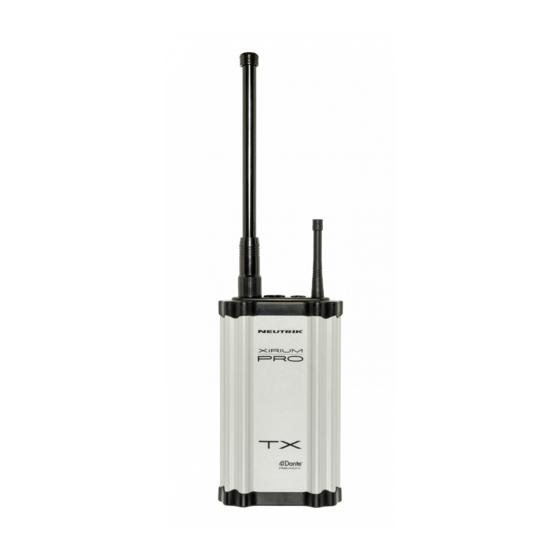
NEUTRIK Xirium Pro Mounting Manual
Hide thumbs
Also See for Xirium Pro:
- User manual (60 pages) ,
- Quick start manual (2 pages) ,
- Quick start manual (2 pages)
Table of Contents
Advertisement
Quick Links
Advertisement
Table of Contents

Summary of Contents for NEUTRIK Xirium Pro
- Page 1 Mounting Guide Certified for U-NII-3 ISM band 2017-07 V2...
- Page 2 Line-of-sight + redundant RF path For a reliable wireless audio link, make sure all XIRIUM PRO devices have line-of-sight. If a link cannot be established with line-of-sight, the receiver may be in a drop-out zone. A drop-out zone is a point where phase cancellation occurs between the direct signal and the deflected one.
-
Page 3: Antenna Height + Distance
Antenna height + distance Consider the Fresnel zone, which is an ellipsoid shaped area between wireless devices. XIRIUM PRO TX and RX units should be free of any obstacles within the Fresnel Zone. Maintaining proper antenna height becomes essential to ensure trou- ble-free communication between XIRIUM PRO devices. - Page 4 TX and any RX should be 10 meter*. min. 10m* When these factors are properly addressed, consistent links can be established. * For shorter distances enter Advanced Mode tin the Xirium PRO app to enable the RF attenuator on the RX.
- Page 5 Antennas Neutrik offers two different antennas for the XIRIUM PRO Europe version: NXPA-6-360-25 NXPA-14-40-35 25° 35° vertical vertical 360° 40° horizontal horizontal Use this antenna for each TX To increase the RSSI level all and for a RX with a repeater...
- Page 6 Use this antenna in combination with an antenna cable (e.g. Neutrik‘s NKXPA-5) as a remote antenna setup: NXPA-18-18-18 18° vertical 18° horizontal Due to RF regulations, directional antennas NXPA-14-40-35 and NXPA-18-18-18 may only be used with audio module equipped receivers, not with repeaters or transmitters.
- Page 7 Please make sure that the antennas of each device are at the same height with respect to each other (this is not the same as having equal height from ground-level).
- Page 8 Here, antennas are shown at different heights, but are aligned at the same angle with a clear line-of-sight.
- Page 9 Signal quality display The Signal quality bar displays both RSSI level and packet loss. The number of bars (left to right) refers to the RSSI level (Received Signal Strength Indicator), whereas the color of the bar meter displays the packet loss. Green bars indicate low packet-loss, amber bars indicate moderate to bad packet loss, and red bars indicate critical packet loss.
- Page 10 Example 1 Although the RSSI level from the TX is low (indicated by the amber colored low bar and bracket), the packet-loss is good (green). The solution to improve the transmission path would be a repositioning of the devices. Example 2 The RSSI level is good from the TX.
-
Page 11: Xroc Mode
XROC mode When a Transmitter is sending a single audio channel, consider activating XROC mode. XROC stands for “Extreme ruggedized one channel”. XROC mode employs a different modulation technique, which alters the data-rate. This creates a wireless link which is less susceptible to RF interference, while still maintaining the studio quality and zero compression of the audio signal. -
Page 12: Overcoming Obstacles
Overcoming obstacles The use of a repeater (RX base station with Repeater module installed), will provide a redundant RF path, allowing audio transmission from a second location. The use of a repeater also helps overcome RF signal barriers, such as walls, glass, and corners. -
Page 13: Multiple Transmitters
• Maintain one unoccupied RF channel between transmitters. The XIRIUM PRO app performs this function automatically. If the transmitter channel is selected manually the user must make sure to assign non-adjacent channels. - Page 14 30 m min. 0,3 m Enjoy using the XIRIUM PRO system!



Need help?
Do you have a question about the Xirium Pro and is the answer not in the manual?
Questions and answers